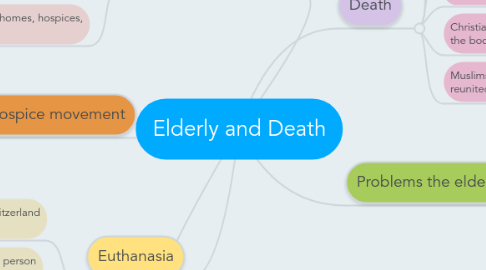Elderly and Death
by Emily Walker

1. Caring for the elderly
1.1. Living at home - Getting help once/twice a week from services or family
1.2. Living with family - Many see the elderly as important family members who should live with them
1.3. Community options - care homes, hospices, sheltered houses
2. Euthanasia
2.1. Illegal in Britain but legal in Switzerland (Dignitas) and the Netherlands
2.2. Euthanasia is allowed as long as the person wanting to die hasnt been forced or family/partner want money from them - REGINALD CREW
3. How long should we keep people alive?
3.1. Life support machines let people stay alive by helping them to brathe or feeding them fluids threw tubes in hope for them to be able to do things by themselves
3.2. Medical technology has advanced so we are able now to keep people alive if they have a difficult illness
4. Hospice movement
4.1. Set up in 1967 - Hospices give people care and offer comfort for people with not much time left. They also comfort and support families and friends.
4.2. There are also hospices for children too where specific needs are catered for and try to make there lives as normal as possible.
5. Death
5.1. End of life
5.2. Body no longer breaths or has a heart beat
5.3. End of physical or metal life
5.4. Christians believe it's when the sould leaves the body - Soul survives forever
5.5. Muslims believe body and sould will be reunited on judgement day
6. Problems the elderly have
6.1. Poverty due to lack of money in pensions
6.2. More vulnerable to illness
6.3. Less mobile - have to rely on family
6.4. May be lonely if family has died


